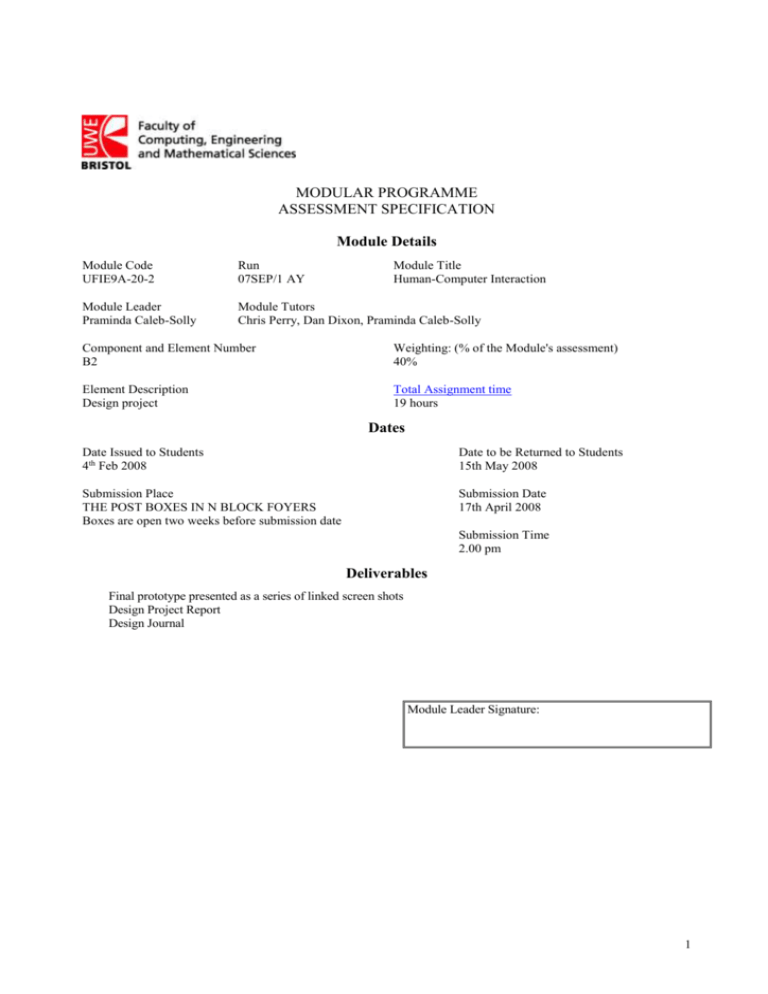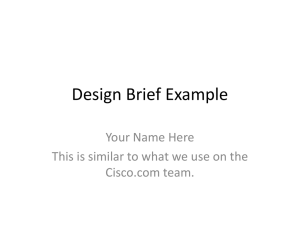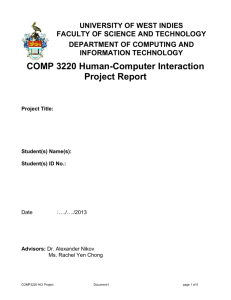UQI120S2 Coursework Assignment
advertisement

MODULAR PROGRAMME ASSESSMENT SPECIFICATION Module Details Module Code UFIE9A-20-2 Run 07SEP/1 AY Module Title Human-Computer Interaction Module Leader Praminda Caleb-Solly Module Tutors Chris Perry, Dan Dixon, Praminda Caleb-Solly Component and Element Number B2 Weighting: (% of the Module's assessment) 40% Element Description Design project Total Assignment time 19 hours Dates Date Issued to Students 4th Feb 2008 Date to be Returned to Students 15th May 2008 Submission Place THE POST BOXES IN N BLOCK FOYERS Boxes are open two weeks before submission date Submission Date 17th April 2008 Submission Time 2.00 pm Deliverables Final prototype presented as a series of linked screen shots Design Project Report Design Journal Module Leader Signature: 1 UFIE9A-20-2 Human-Computer Interaction Coursework Assignment Component B Element II %Weighting = 40% of Module Assessment Hand in Date: 17th April 2008 This project involves re-designing the interface for the Personal Trainer Application that you evaluated for the previous coursework assignment. Key points to note: You are not required to build a working implementation of the system, just employ human-centred design principles to re-design the graphical user interface for the system with screens that will be intuitive, easy, efficient and pleasant to use, i.e. one that satisfies all usability criteria and guidelines for good design. So please ensure that you also consult relevant books and journal papers relating to human-centred design and usability to guide your work. Your design journal needs to clearly demonstrate prototype development using an iterative design process. You will be working on the different aspects of this assignment in the tutorial sessions so you will be expected to record your activities and reflections on a regular weekly basis in your design journal. Your design should employ a range of interaction components (controls) such as text boxes, radio-buttons, check-boxes, buttons, picture-boxes, labels etc. as appropriate. Assignment Learning Outcomes: This coursework should help you to achieve the following overall learning outcomes: □ Gain knowledge and understanding of usability and human-centred approaches for interaction design □ Develop ability to apply human-centred design methodologies and identify and interpret standards and guidelines for interaction design □ Develop ability for recognising and understanding the human and environmental characteristics which must be taken into account when designing interactive systems The deliverables should comprise the following: 1. Final prototype presented as a series of linked screen shots (50%) 2. Design Project Report (Word count: between 2000 - 2500 words) (50%) 3. Design journal – A record of your design process over the course of the assignment To be submitted as evidence of the work undertaken and to validate your final prototype and report. 2 The details of the deliverables are as follows: 1. Final prototype presented as a series of linked screen shots (50%) To include o A step-by-step illustration of how a user would complete two different tasks (such as entering their personal details and selecting an activity for a certain day) demonstrated using screen dumps of your interface screens. Assessment criteria: o Ability to use HCI principles and guidelines effectively in the screen designs o Designs supported by a rigorous iterative design process recorded in the design journal o The interpretation and representation of your task and requirements analysis in the designs o The evidence of care in the presentation of work 2. Design Project Report (Word count: between 2000 - 2500 words) (50%) To include: o A comprehensive evaluation of your final prototype (20%) o A reflection on your design journal addressing the following: (20%) The scope and thoroughness of the journal entries and the extent to which they contributed to the design (feel free to reference the relevant pages in journal as appropriate) The extent to which there is detailed consideration of alternative designs and how this has impacted on your final design o A reflection on how the overall design process could have been improved and why. (10%) Assessment criteria o The rigour of your evaluation of your final prototype o Level to which the reflection on the design journal is an authentic and thoughtful consideration of the contents of the journal o Evidence of understanding of the shortcomings of your approach to HCD in terms of the suitability of the methods/techniques used and resources available including time, expertise and tools. Appropriateness of other HCD methods and techniques suggested in terms of the given problem domain. o Reference to sources as appropriate 3. Design journal – A record of your design process over the course of the assignment To be submitted as evidence of the work undertaken and to validate your prototype and report, including: o Weekly reflective logs of work undertaken (Example headings - main activities this week, problems I had, how I resolved them, what I have learnt, what I am left wondering) o List of requirements and updates to requirements as appropriate o Notes on your conceptual designs and evidence gathering to support these o Sketches of prototype screens o Prototype evaluations at each design iteration 3 Overall Marks Guide A mark below 40% will indicate failing to achieve all the learning outcomes specified for this assignment. Most typically, such an assignment will provide no or poor evidence of: well thought through designs conforming to usability heuristics and requirements progressive development of ideas recorded in the design journal on a continuous basis, understanding of human-centred design techniques. A mark in the 40 – 49% range will indicate sufficient coverage of issues: there may be some evidence of reflection, progressive development of ideas, having used or referred to the relevant methods and guidelines for evaluating and designing for usability. The designs, however, may not necessarily reflect the usability requirements. A mark in the 50 – 59% range will indicate ample treatment of issues: there will be adequate evidence of reflection, progressive development of ideas, having used or referred to the relevant methods and guidelines for evaluating and designing for usability. The designs, however, may not fully reflect the usability requirements. A mark in the 60 - 69% range will indicate that the presented work is at a good level of achievement. The writing will be thoughtful, showing clear understanding of HCI concepts. There will be evidence of this understanding in the prototypes, which should demonstrate that the work has been conducted in a progressive manner paying attention to usability issues. There will be a good attempt at evaluation of the prototypes and reflection on the design process. A mark in the 70 - 89% range will indicate that the presented work is at high level of achievement. The writing will demonstrate a deep understanding of HCI concepts through critical analysis of work where appropriate. There will be clear evidence of having conducted the work in a rigorous and progressive manner. This will include well thought out designs, and the evaluation of prototypes that clearly relate to usability issues. The prototype screens and report will be presented to a high standard and also include appropriate references to relevant HCI literature from journal papers, books and web sites. A mark of 90% and above will indicate that the presented work is at an excellent level of achievement. The writing will demonstrate a comprehensive grasp of HCI concepts with a well developed understanding of social and environmental implications. The prototype screens and report will be presented to a very high standard with close attention to detail. The designs of the prototype will show creativity clearly balanced with careful consideration of usability and other requirements. There will be clear and comprehensive evidence of rigorous evaluation of prototypes. The critique of the design process and suggestions for improvements will demonstrate an excellent attempt at understanding the application domain. The work will be underpinned by appropriate HCI literature. Plagiarism Warning: You must ensure that you cite all your sources using an appropriate referencing technique. This not only demonstrates your initiative but also your academic maturity for utilising and evidencing a range a related literature. All presented work and designs must be the product of your own independent effort. 4





